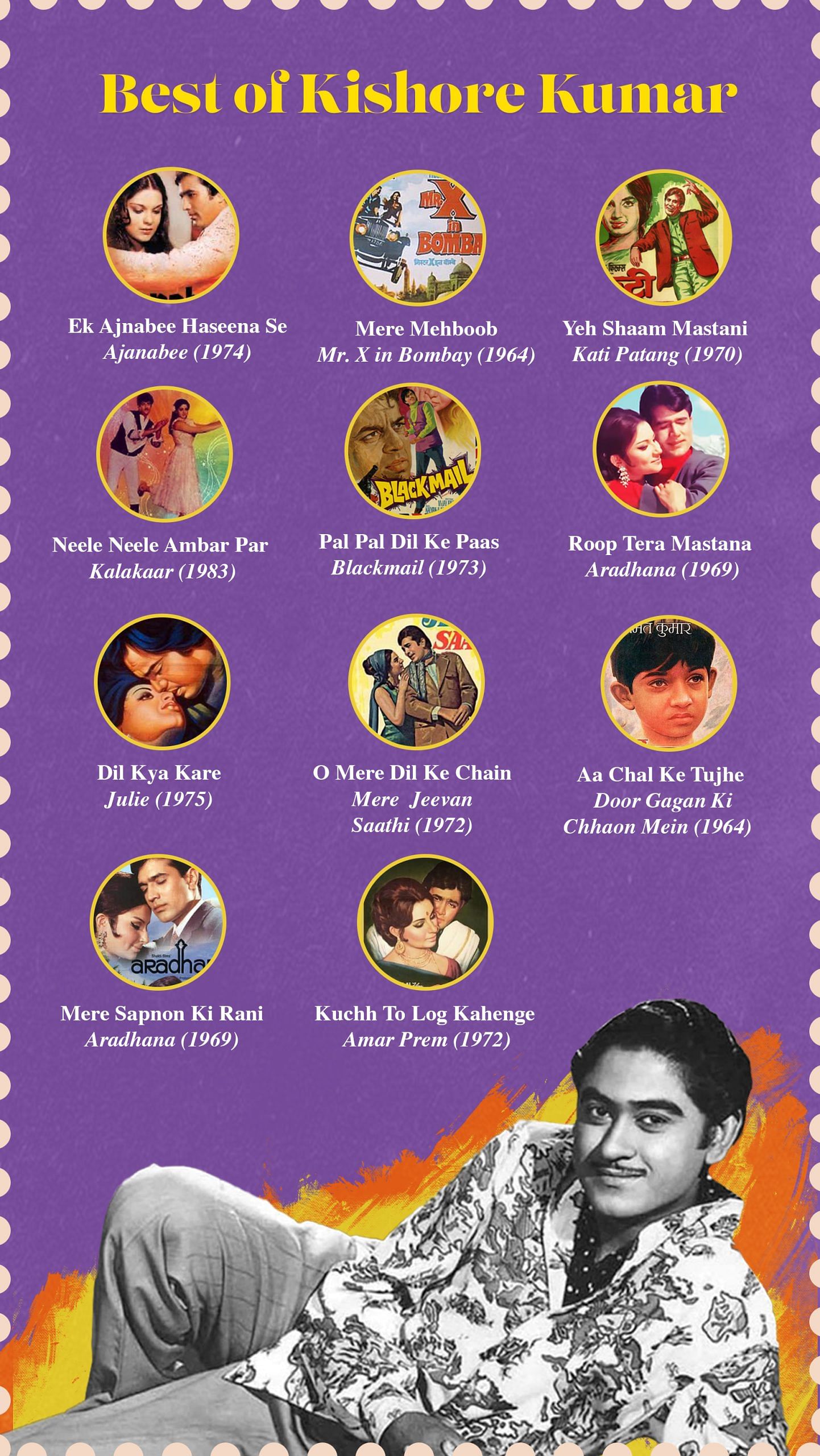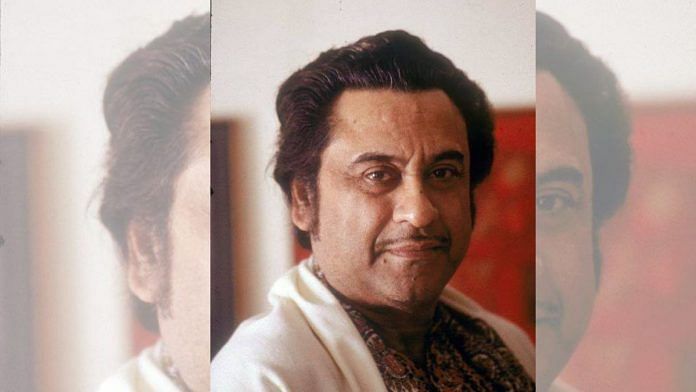Kishore Kumar made a remarkable shift in his career in the early 1960s. He strayed from his image as a comedic actor and decided to venture into serious filmmaking. Inspired by Italian neorealism and Satyajit Ray’s 1955 award-winning film, Pather Panchali, he embarked on making a somewhat-sombre film, Door Gagan Ki Chhaon Mein.
Released in 1964, Door Gagan… was his dream project, for which he wore many hats, playing the lead, directing, producing, composing the music, and singing. This critically-acclaimed film showcased a different side of Kishore as he played a melancholic character. Whether singing a love song, delivering a dramatic scene, or directing a poignant moment, Kishore captivated the audience throughout.
The film explores the sensitive relationship between a father and son, who loses the ability to speak after his mother dies in a fire. Shankar (Kishore) is a war-returned soldier who finds his house burnt to ashes, his wife dead and his son Ramu (Amit Kumar) non-verbal due to the shock. Shankar wants to get his son treated but the doctor is unable to figure out the reason behind the boy’s silence.
The plot was inspired by the 1958 Hollywood film The Proud Rebel, directed by Micheal Curtiz, who made several award-winning movies including Casablanca (1942). Kishore’s black-and-white remake preserved the essence of the original, whose poster proclaimed that it was “a story that reaches far and wide as the human heart”.
Searching for a boy actor to play Ramu, Kishore published a newspaper ad. But even after auditioning several child artists, he was unable to find the right cast. Noting that The Proud Rebel starred actor Alan Ladd and his 10-year-old son David, cinematographer Aloke Dasgupta and actor Iftekhar suggested Kishore cast his eight-year-old son Amit.
This was Amit’s debut film and he was credited as Amit Ganguly. He recalled in a podcast: “In my screen test, I had to say this line: Bapu, tum kab aaoge? (Father, when will you return?) As soon as I uttered my line, Baba exclaimed ‘very good!’ and I instantly bagged the role… but the film took three years to get fully made.”
Lyricist Kishore Kumar
Door Gagan… featured many moments of tenderness between the father and son, with the film’s visuals and music playing a key role in conveying its emotional core. Kishore composed eight brilliant songs for the film and roped in his favourite lyricist, ‘Kaviraj’ Shailendra, to write all the songs except one, which he wrote himself.
This song was Aa Chal Ke Tujhe, which holds a special place in the history of Indian motion picture music. It is perhaps the only Hindi film song written, composed, sung, enacted, directed, and produced by a single artist.
Kishore wasn’t looking to create a record of this kind, but circumstances compelled him to put up this one-man show. He had to handle multiple roles in the production due to financial pressures, mainly caused by the mounting medical expenses of his ailing wife, Madhubala. But that didn’t deter him from starting the shoot on a shoestring budget with the initial expenses covered by mortgaging his mother’s jewellery.
Reportedly, Kishore was also not able to pay Shailendra on time and was so focused on cutting costs that he shared the responsibility of writing the dialogues and lyrics for the film. Aa Chal Ke Tujhe was born out of this necessity.

Once Kishore had written the lyrics, he requested Shailendra to vet the song. “Shailendra ji absolutely loved Baba’s lyrics, and made no change in the entire song except for one word,” said Amit.
Kishore never made a big deal about his songwriting skills. In the movie, he did not credit himself as a lyricist out of sheer respect for Shailendra. Only the LP record of the film’s music revealed that the song was written by Kishore. Such is his legacy and greatness.
Also read: Edwina Violette was more than a ‘background’ dancer. ‘Could have become the second Helen’
Success of ‘Door Gagan…’
Kishore loved the craft of filmmaking. He highly respected, and drew inspiration from, Satyajit Ray. Ray’s famous Apu trilogy influenced both Door Gagan… and Door Ka Rahi (1971). Kishore called him Manik Mama, having married his niece Ruma. He donated Rs 5,000 to Pather Panchali, which, according to Ray, “enabled us[them] to continue the shooting.”
After attending a private screening of Door Gagan…, Ray praised Kishore’s all-round effort in filmmaking, calling him a “tragic heart” behind the facade of a comedian.
In a documentary produced by Ray’s son Sandip after Kishore’s untimely death in 1987, Ray said, “It[the film] had some very interesting touches and a lot of pathos, and he was quite happy with it himself.”
Kishore and his team’s hard work seemed to have paid off as Door Gagan… received great reviews. He thanked his team’s effort by adding a dedication to the film: “To All Workers Big or Small Whose Efforts Have Made the Creation of This Motion Picture Possible – OUR HUMBLE THANKS!”
The film, however, had a sluggish start, only picking up steam a few weeks later. “Baba used to take me to Alankar Cinema, where we waited for the ‘HOUSEFULL’ board to come up. After that, we would happily drive back home. Seeing the house full board gave Baba immense satisfaction. The film ran for 23 weeks in the theatres, and it made history!” Amit said.
He went on to add that Door Gagan… not only gave Kishore an identity but also established him as a serious director. No wonder, even today’s audiences have rated the film 8.2/10 on IMDb.
In 1998, Anand Patwardhan made a 5-minute music video for Aa Chal Ke Tujhe, using it in a peace campaign following Pokhran-II, where India conducted five nuclear tests in rapid succession. Titled Ribbons for Peace, this commentary on war added new meaning to a song Kishore had crafted with tenderness, care, and hope.
Subhamoy Das is a former journalist. He tweets @subhamoy_das.
This article is part of an upcoming book on Kishore Kumar by the author.
(Edited by Prasanna Bachchhav)





Brilliant 👏